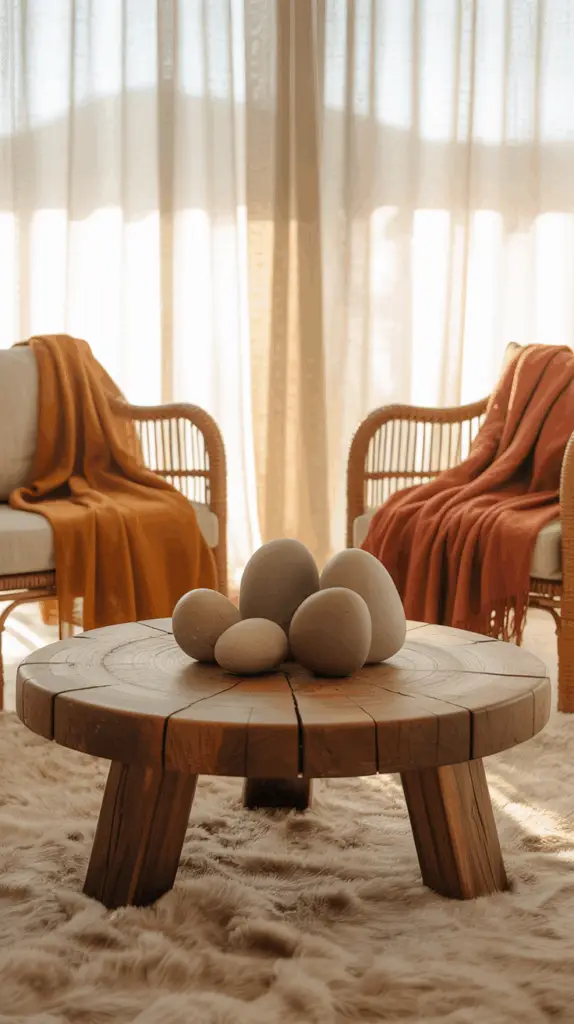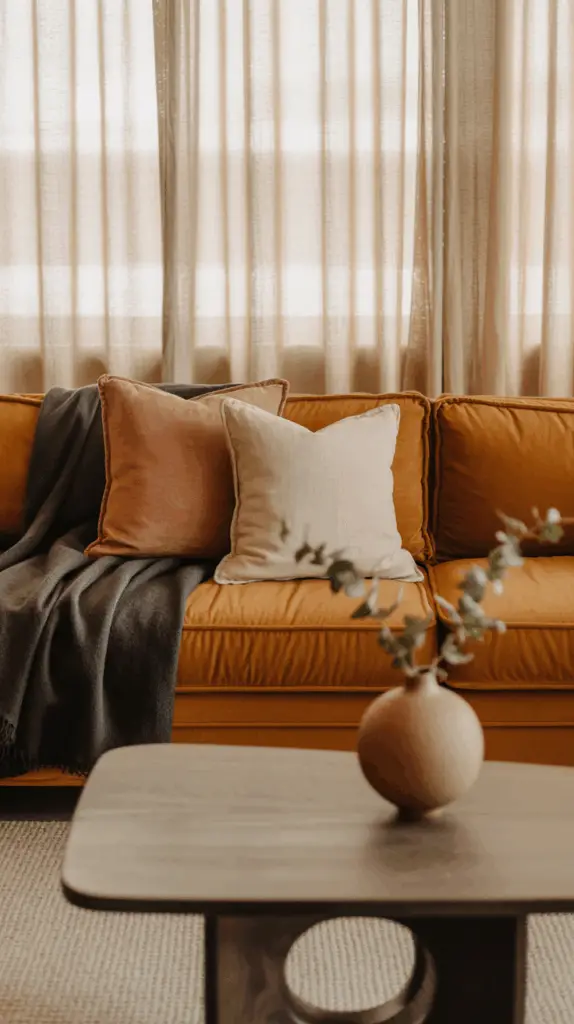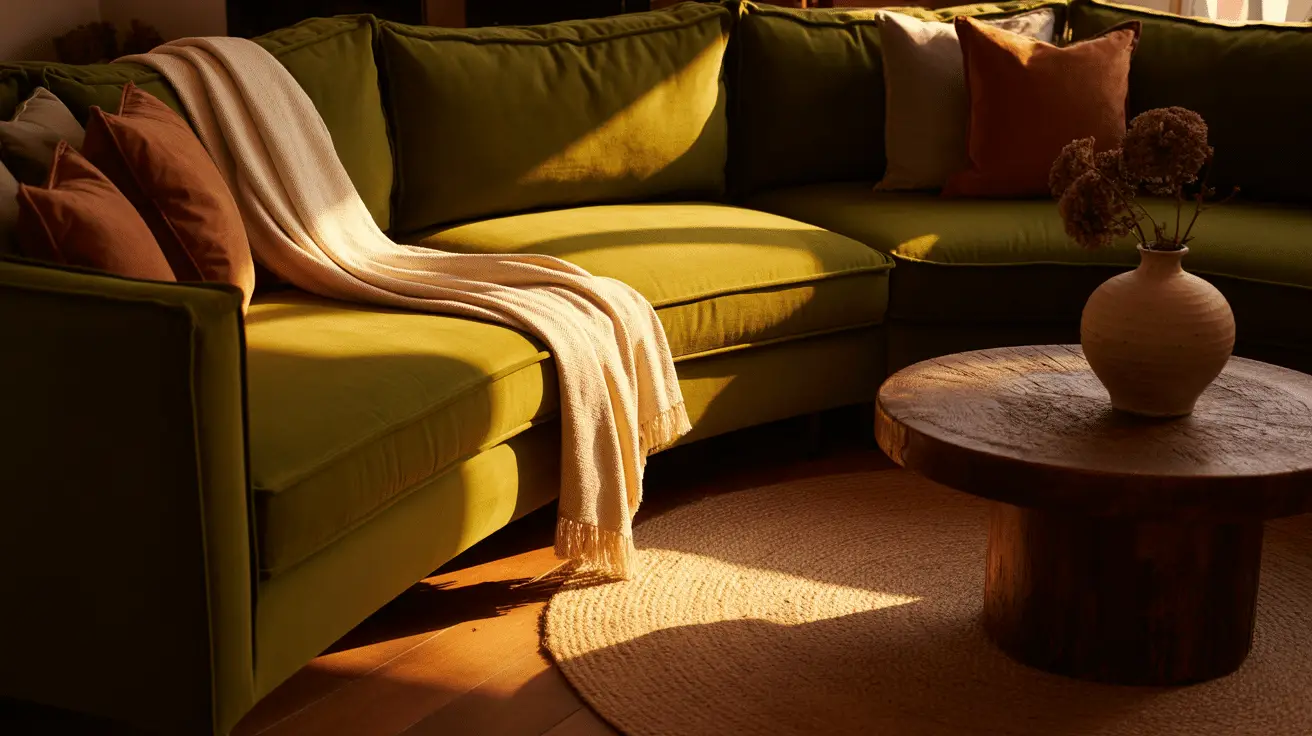Layering Textures in Warm Earthy Living Room Interiors: Create a Cozy, Inviting Space with Natural Elements
Table of Contents
Introduction
There’s something inherently calming about warm, earthy tones in a living room—like the soft embrace of nature itself. But while colors like terracotta, ochre, and moss green set a solid foundation for earthy interiors, it’s the art of layering textures that truly brings these spaces to life. Imagine sinking into a plush velvet couch adorned with woven throws, surrounded by rustic wooden furniture, and the subtle texture of jute rugs underfoot. The result? A living room that feels both inviting and rich in character.
Layering textures in a warm earthy living room isn’t just about mixing materials; it’s about creating harmony and depth that invites both visual interest and tactile enjoyment. Whether it’s the juxtaposition of rough-hewn wood and smooth stone or the mix of soft linens and woven fabrics, these elements work together to build an environment that feels grounded and sophisticated.
In this post, we’ll dive into the world of texture layering for your living room, providing tips and inspiration for combining different materials to create a balanced, cozy, and stylish space. From the furniture to the textiles, and the decorative accents in between, learn how to use textures to transform your living room into a sanctuary of warmth and style.
1. Start with a Rich, Earthy Color Palette
The foundation of layering textures in any space begins with color. For a warm, earthy living room, start by selecting a color palette that reflects the beauty of nature. Warm tones like terracotta, burnt orange, ochre, deep green, and soft browns provide a welcoming backdrop that instantly evokes a sense of calm and comfort. These earthy shades set the tone for the entire room and allow the textures you layer to shine.
When working with a rich color palette, be mindful of how light and dark hues interact with each other. A mix of deeper tones, such as dark chocolate and olive green, with lighter shades, like beige and ivory, will create a dynamic and visually appealing contrast. Use the darker colors for larger elements like walls and furniture, while lighter tones can be used for accent pieces, textiles, and decor.
Additionally, consider using muted tones, such as sage or dusty rose, which complement earthy tones and allow the textures to stand out without overwhelming the space.
Color Palette Ideas:
- Terracotta and burnt sienna with accents of creamy ivory.
- Deep moss green, mustard yellow, and soft beige.
- Charcoal gray with earthy tan and rust hues.
- Olive green, warm taupe, and golden ochre.
2. Mix Natural Materials for Depth and Warmth
One of the best ways to layer textures in your living room is by using a mix of natural materials. These materials, like wood, stone, clay, and wool, add warmth, authenticity, and richness to your space. By incorporating various textures through furniture, flooring, and accessories, you can create a balanced environment that feels connected to the earth.
Start with a wooden coffee table or shelving unit as the centerpiece of the room. The natural grain of wood adds a rustic yet elegant touch. Combine this with stone or marble elements—perhaps a sculptural vase or a textured lamp base. Adding tactile elements like woven baskets, rattan chairs, or linen curtains softens the harder surfaces, balancing the room’s overall feel.
Materials to Layer in Earthy Living Rooms:
- Wood: Coffee tables, shelving, picture frames, or wooden beams.
- Stone: Sculptural decor, vases, or marble tabletops.
- Woven materials: Rattan chairs, wicker baskets, and jute rugs.
- Clay and ceramics: Pottery, bowls, or decorative objects.
- Wool and linen: Cushions, throws, and curtains.

3. Play with Fabric Textures to Add Softness
While natural materials like wood and stone bring structure and warmth, fabric textures are key to introducing softness and comfort into the space. Layering different fabrics—think velvet, linen, wool, and cotton—creates visual and tactile interest, making the room feel inviting and cozy.
Start with your seating: a velvet sofa in a rich, earthy color like deep mustard or burnt orange can be both luxurious and soft to the touch. Add woven linen or cotton cushions for a textured contrast, and layer in a wool throw blanket for warmth. Consider mixing different fabric textures on your furniture and textiles to create a cohesive, well-balanced look. The contrast between a plush velvet pillow and a rough linen cushion is visually pleasing and adds depth.
Fabric Ideas for Layering:
- Velvet cushions and throws in rich, earthy hues.
- Linen or cotton slipcovers for a relaxed, casual vibe.
- Wool rugs or throws for added warmth and texture.
- Leather accents for an unexpected contrast with soft fabrics.

4. Incorporate Statement Rugs for Texture and Color
Rugs are an essential element for layering textures in your living room. A statement rug can tie together your color scheme while adding both softness and pattern to the space. Look for rugs that incorporate natural fibers like jute, wool, or cotton for an earthy, textured feel.
For a warm, earthy living room, opt for rugs in neutral tones with intricate woven patterns or textured weaves. A natural jute rug can bring an organic, rustic feel, while a wool rug with a soft pile can introduce warmth and comfort. Layering rugs is also an option—placing a smaller, patterned rug over a larger, neutral base rug creates added dimension and texture.
Rug Layering Tips:
- Use natural fiber rugs like jute, sisal, or wool to keep the earthy theme intact.
- Consider layering smaller rugs on top of larger ones for added texture.
- Opt for a rug with a subtle pattern or texture to avoid overwhelming the space.
- Make sure the rug size is proportional to the room’s layout—too large or small can disrupt the balance.
5. Add Natural Greenery for a Fresh, Earthy Touch
Bringing plants into your earthy living room is an essential element for adding life and freshness. Greenery adds contrast to the earthy tones while softening the hard edges of furniture and other decor items. Plants not only introduce color but also contribute to the textural layering, with their various shapes, sizes, and leaves adding an organic touch to the space.
Large potted plants like fiddle leaf figs, palms, or rubber plants create a focal point, while smaller plants like succulents or trailing vines can be used as decorative accents on tables or shelves. Pairing plants with textured ceramic or clay pots enhances the earthy vibe while creating visual interest.
Plant Styling Tips:
- Place large plants in corners or near windows for a striking, natural focal point.
- Use decorative, textured planters to complement the room’s aesthetic.
- Incorporate smaller plants on shelves, side tables, or mantels for added layers of texture.
- Mix different types of plants—sprawling, leafy plants combined with succulents or cacti create variety.
6. Use Warm Lighting to Highlight Textures
Lighting plays a crucial role in showcasing the textures you’ve layered in your living room. Soft, warm lighting can enhance the richness of natural materials and fabrics, while also creating a cozy, inviting atmosphere. Use a combination of ambient, task, and accent lighting to highlight different textures and create a balanced, well-lit space.
For a warm, earthy interior, opt for lighting fixtures in natural materials like wood, brass, or woven wicker. Floor lamps and table lamps with fabric shades in warm tones can diffuse the light and create a soft, ambient glow. Accent lighting can be used to draw attention to specific textures, such as highlighting the grain of a wooden table or the pattern of a woven rug.
Lighting Tips:
- Use warm-toned bulbs (2700K or lower) to create a cozy, inviting atmosphere.
- Layer lighting sources—ambient, task, and accent lights work best together.
- Choose lighting fixtures in natural materials like wood, woven rattan, or brass to enhance the earthy vibe.
- Consider adjustable lighting for flexibility—dimmer switches allow you to control the mood.
Conclusion
Layering textures in warm earthy living room interiors is a powerful way to create a space that feels grounded, cozy, and visually intriguing. By thoughtfully combining natural materials, varied fabrics, rich colors, and plenty of greenery, you can design a room that exudes comfort and sophistication. The key is balance—ensuring that each texture complements the others while adding depth and warmth to your living space. With these tips and ideas, you’ll be well on your way to crafting a stylish and inviting living room that’s both earthy and modern, timeless yet fresh.

